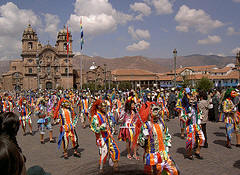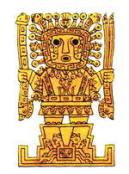Viracocha
The supreme deity or god of Incan Mythology was the creator Viracocha. Viracocha was both the god who created the world and also a man who traveled the earth doing great deeds. Viracocha created the world and the sky with all it's stars and he brought the sun and the moon out of an island in lake Titicaca to light it. He then went to Tihuanaco and formed people and animals out of clay. According to Incan mythology, after travelling through the country instructing his people, Viracocha set off across the Pacific from the shores of Ecuador, walking on the waves. His form was that of a man and he was thus represented in images in temples. One such statue of solid gold, was in Cuzco; it stood 4 feet high. The figures right arm was raised and it's fist was clenched, except for the thumb and forefinger. He was eternal and created everything including other deities. The three principle gods under Viracocha were Inti-The Sun, Illapa-The Thunder or Weather god and Mamaquilla -The Moon.
There are many legends on Viracocha. One legend says Inti was his son and Mama Quilla and Pachamaam were his daughters. According to this legend he created a flood and destroyed the people around Lake Titicaca. He saved only Manco Capac and Mama Ocllo so that they can bring civilization to the world. Afterward Manco Capac and Mama Ocllo founded the Inca civilization.
Inti
The Inca were sun worshippers; the sun Inti was the god of agriculture. Inti was represented as a golden disk with rays and a human face in the centre. Although the priests and the chosen women served all the gods, the sun was so pre- eminent that the chroniclers always referred to the women as the "Virgin of sun" and to the shrines as "Sun Temples".
Inca believed Inti was the son of Viracocha. The Sapa Inca was believed to be direct descendent of Inti or Sun. Inca legend says Inti taught Manco Capac and Mama Ocllo the art of civilization and then he sent them to earth so that they can bring civilization to earth. One legend says Manco Capac was his son, though it is a bit confusing as in another legend Manco Capac was stated as son of Viracocha.
Illapa
Illapa the next most powerful god was associated with rain. Illapa the thunder or weather god was envisaged as a man dressed in shinning apparel and carrying a sling and a war club.
The gods of the sky, Inti and Illapa were important to the Incas, no doubt ,because the sky was the source of both sun and rain for sustaining crops.
Mamaquilla
The moon, Mamaquilla, was a goddess and a wife of the sun. She was little worshipped but her functions were chiefly with reference to the calendar and the festivals and work connected therewith.
The Earth and Sea Goddesses, Pachamama and Mamacocha, were of importance in the highlands and on the coast respectively. There functions dealt with agriculture and fishing. Mamacocha was also the ultimate source of all water, including rivers, streams and irrigation water. Hence she was important even to the Incas in Cuzco
In additions to worshipping he deities, the Inca worshipped the numerous huacas -sacred places -which were everywhere throughout the Inca Empire. Mountaintop were huacas, because man could not penetrate them. The emperor's palace, with all his goods, was sealed after his death and became a huaca. Battlefields, caves, springs, quarries, and even the roots were Huacas. There always seemed to be room for more huacas in the religions of the Andeans. When the Inca conquered a village and introduced new huacas, the villagers gladly accepted them.
A man would sprinkle a few coca leaves as he passed a huaca. If he had no coca leaves, he placed a stone near it, as many had done before him. Thus huacas were distinguished by the piles of stone. If he had nothing at all to offer, he pulled a few hairs from his eyebrows and lashes and blew them toward the shrine. Many huacas had shelters nearby. A priest lived in the shelter, caring for the shrine and cultivating a small field beside it in honor of the huaca.






